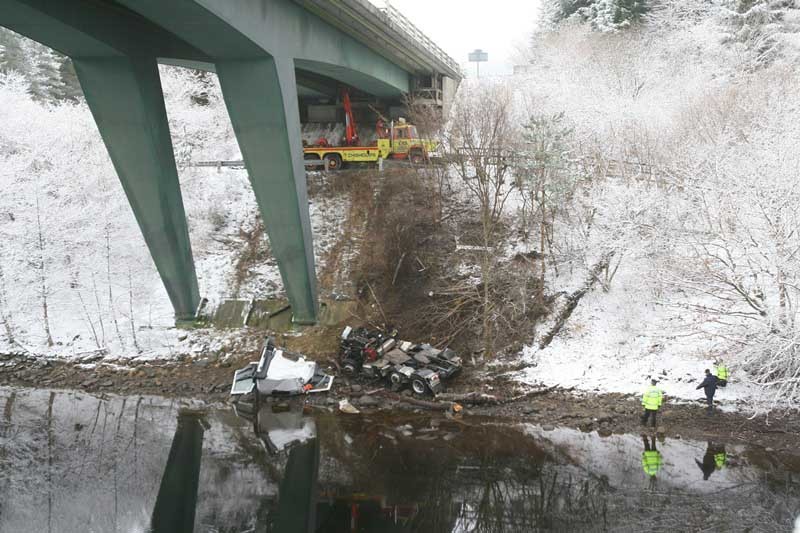The death of an experienced lorry driver in a horror road accident in Perthshire last year was caused by “driver error,” a sheriff has found.
Though he admitted having been unable to say why Andrew Raeside’s oil tanker left a snow-covered A9 last year, Sheriff Lindsay Foulis said the evidence made that the only possible conclusion.
In his written findings, published following a fatal accident inquiry at Perth Sheriff Court last last year, he found the accident could have been avoided had Mr Raeside been driving “within the speed limit applicable at the locus and at a speed appropriate for the road conditions at the time of the accident.”
The 54-year-old Brogan Fuels employee, from Gartshore Estate, Kirkintilloch, had been making his way back to Grangemouth after delivering kerosene to Muir of Ord on the Black Isle when the accident took place.
The fatal accident inquiry heard that shortly after midnight on February 4 last year, his 44-tonne tanker jack-knifed in poor conditions and crashed into the parapet barrier on the Coronation Bridge.
Such was the impact, the articulated vehicle’s tractor unit and cab came away from the trailer and tore through the barrier before tumbling over the edge.
They plummeted 20 metres to Loch Faskally below, before coming to rest in its freezing waters.
Despite the efforts of emergency staff, Mr Raeside was pronounced dead at the scene.
A pathologist from Dundee University told the inquiry Mr Raeside suffered multiple chest injuries as a result of the impact, and would have been killed “almost instantaneously.”
Mr Raeside was described as “an excellent driver” who was “responsible and a meticulous record keeper.”
He was driving a vehicle said to be “well-maintained and relatively new and with no defects discovered other than those directly attributable to the accident.”
In his detailed written findings, Sheriff Foulis said it was “clear that road conditions had been a possible contributory factor to the accident.
“At the time of the accident, the weather and road conditions were not ideal,” he writes. “There were flurries of snow.
“This resulted in snow lying on the road surface, which was slippery as a result, while the snow flurries also reduced visibility.
“One witness described the road surface as slushy, requiring a driver to take care, while another driver indicated that he would not have wanted to apply his brakes quickly as a result of the road conditions.”
While accepting Mr Raeside had not been wearing his seatbelt at the time of the accident, the sheriff said he did not believe this had contributed in any way to his death.
He said it was clear Mr Raeside had lost control of his articulated lorry, that the lorry had collided with the barrier bounding the northbound carriageway of the Coronation Bridge and that the cab breached that barrier.
While accepting the weather could have played a part, the sheriff questioned whether Mr Raeside’s driving might also have had an effect.
The speed limit for a vehicle like that driven by Mr Raeside was 40mph while on a single carriageway and 50mph on a dual carriageway section.
From the examination of the tachograph in the deceased’s vehicle, although the last 60-70 seconds of the journey had not been recorded, the speed of the vehicle immediately prior to that was recorded at between 50 and 56mph over a 60-second period.
“The readings of speed from the tachograph for the 60 seconds prior to its ceasing to operate would indicate that the deceased was exceeding the speed limit by between 10 and 20% during that stage,” Sheriff Foulis said.
“The speed readings are fairly consistent, and I am satisfied that it is likely the deceased was travelling at a speed in excess of the speed limit applicable for the vehicle he was driving at the time of the accident.
“In the crash investigation report, the authors indicated that there were three possible causes of the jacknife, although alternatively the jacknife was caused by a combination of these three factors.
“While I am satisfied that the deceased was travelling at excessive speed for the road and the conditions, in light of the evidence, I cannot come to any determinative conclusion that that played any part in the accident.
“I cannot conclude that excessive speed of the part of the deceased caused the accident, but it is a factor that could have done so.
“In light of the conclusions reached by the accident investigators to the effect that all the causes of the accident are to some extent attributable to error on the part of the driver, I consider that I can make that general determination.”
Sheriff Foulis said he offered his sincere condolences to the family of Mr Raeside.
In his findings, the sheriff also considered the structure of the crash barriers at the Coronation Bridge, but said he had no concerns over its design.
“Even if the bridge parapet had been designed to the higher standard, it was unlikely that it would have contained the tractor unit,” he said.
“In any event, in all the circumstances, I do not consider any upgrade of the bridge parapet could be considered reasonable in all the circumstances.”
